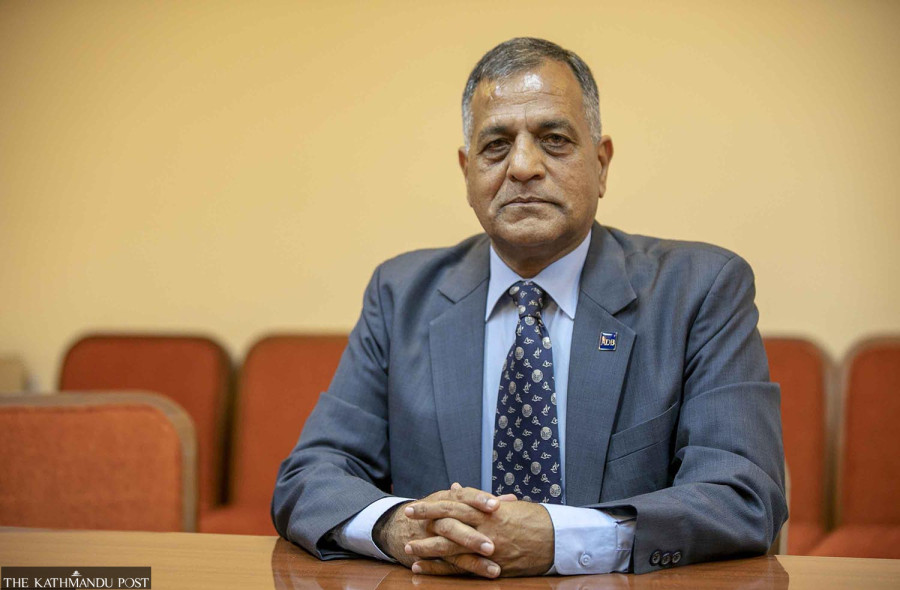Interviews
‘Private sector seeks a consistent and predictable policy regime’
Ashok Lavasa, vice-president for Private Sector Operations and Public Private Partnerships of the Asian Development Bank (ADB), on the private sector’s role in the economic growth of Nepal.
Sangam Prasain
Ashok Lavasa is vice-president for Private Sector Operations and Public Private Partnerships of the Asian Development Bank (ADB). Prior to joining ADB in September 2020, Lavasa was an election commissioner in India from January 2018 to August 2020. He served in various agencies of the Indian government for nearly four decades as union finance secretary, secretary environment, secretary civil aviation, additional secretary and special secretary for power.
Lavasa led the official Indian delegation for climate change negotiations to the Paris Agreement at COP 21. He is currently in Kathmandu to attend the Nepal Infrastructure Summit that kicked off in the capital on Thursday. In an email interview with the Post's Sangam Prasain, Lavasa spoke on a wide range of issues, particularly on the private sector's role in the economic growth of Nepal. Excerpts:
Why is private sector investment crucial for a country like Nepal?
Meeting Nepal’s development goals—as outlined in its 15th Periodic Plan, as well as the Sustainable Development Goals and COP 26 targets and graduating from the least developed country status by 2026—will require resources above and beyond government finance and official development assistance.
Private sector investment, including foreign direct investment and international commercial capital, will be increasingly important to meet Nepal’s investment needs. In the post-pandemic context, many countries face tight fiscal situations exacerbated by the rising price of essential commodities. Global evidence shows that private investment not only bridges the financial gap but fuels the economy and is a catalyst for structural transformation. ADB sees a critical role for greater private sector engagement in the country.
The liberal economic policies adopted by Nepal in the early 1990s provided a significant growth opportunity for the country’s private sector. Except in a few sectors, much could not be achieved. Why is private sector growth lagging in Nepal?
Since the 1990s, Nepal has made good progress in modernising its banking, media, and to some extent, education and health sectors through greater private sector involvement. However, the country lags in modernising its industries, manufacturing and other service sectors. Of late, the IT sector is showing some promise, which must be harnessed further.
The first generation of economic reforms in Nepal in the early 1990s has parallels with India’s, and were implemented during the same period. As in India and elsewhere, the single most important factor that the private sector seeks from a government is a consistent and predictable policy regime. This calls for sustaining the reform momentum and not only ad-hoc reforms. The government, private sector and development partners can join hands and prioritise the next set of reforms for the country. ADB can certainly contribute to this effort. I am confident that Nepal’s private sector has the potential to integrate with the global and regional market. With the right vision and collaborative effort, Nepal can attract more investment, sustain economic growth, and create more jobs at home.
Post-Covid Nepal’s total factor productivity growth has been weak. Imports have reached nearly Rs2 trillion, widening the trade deficit. A low export base has left the economy highly vulnerable to external shocks. How should Nepal tackle this emerging threat to the economy? How can the private sector play a role in this regard?
Nepal should tackle the threat of a widening trade deficit by boosting the export competitiveness of its goods and services, supported by prudent fiscal and monetary policies. The performance of exports has been lacklustre. Nepal has the potential to increase the production and exports of goods and services, including high-value agriculture and agro-processing, textiles and garments, footwear, hydropower, tourism, and information and communication technology (ICT) services.
To achieve this, infrastructure and appropriate policies must be in place, to make it easier for competitive domestic and foreign private firms to emerge. The private sector can collaborate with foreign firms and industries to bring in investment and technical know-how to boost export competitiveness. For instance, to harness its natural advantage in hydropower, the efforts from the public and private sectors should focus on minimising the cost of generation, transmission and distribution. In turn, this may require transborder partnerships to access regional and subregional markets.
ADB stands ready to help its member countries to promote energy trade in the region. Likewise, in tourism, Nepal can work with regional markets to promote tourist circuits that span multiple countries. Currently, Nepal’s potential in tourism has been limited owing to poor tourism infrastructure and limited destinations, as well as regulatory inadequacies underpinning the standards of tourism products and services. These are some areas of mutual interest for the public and private sectors and an avenue for forging public-private partnerships.
The prolonged political instability in Nepal has weakened the country’s governance which has been a critical constraint to private sector investment. The country seems to be headed for instability again. Will the growth momentum of private sector investment continue in this scenario?
Nepal made a successful political transition in 2017 with the completion of local, provincial and federal elections that represented a significant achievement of the peace process. The successful completion of the local elections in May 2022 and the general elections coming soon will further bolster political stability and pave the path for realising the country’s full potential in investment, growth and job creation. The time is right to strengthen institutions and bridge capacity gaps across the three tiers of government.
In recent years, Nepal has made progress in legal reforms and the regulatory environment to attract greater private and foreign investment. Examples include the Foreign Investment and Technology Transfer Act 2019 and Public Private Partnership and Investment Act 2019. The momentum must be augmented to address bottlenecks and promote the growth of industries in areas, such as agribusiness, education, eco-tourism, health, IT and other services. In the near term, Nepal should aim to complete key reforms, including relaxation of the minimum foreign-investment threshold, obtaining a sovereign credit rating, and operationalising the currency-risk hedging mechanism.
Nepal aims to graduate to a middle-income developing country by December 2026. What role should the private sector play to realise the goal?
The private sector can play a crucial role in revitalising Nepal’s manufacturing and services sectors and strengthening export performance to achieve high income growth without the benefits that LDCs receive in the international trading system. The government could establish a coordination mechanism among key stakeholders, with a detailed graduation plan and strategy, for Nepal’s smooth transition to a developing country category in 2026.
With investment facilitation measures, the private sector could explore ways to strengthen productive capacity, improve goods competitiveness, and diversify exports. The focus should be on enhancing competitiveness of goods and services with comparative advantages.
Public investment in infrastructure in key areas such as energy and transport continues to be low. How should Nepal leverage its key resources for job creation and growth?
ADB acknowledges that the quality and quantum of public expenditure in infrastructure needs to be enhanced. The energy and transport sectors occupy a large share of our sovereign portfolio in Nepal. I understand that these are priority sectors for the government as well.
In energy, we are witnessing a gradual but continuous shift away from public towards private investment in hydropower generation. In my view, the government’s orientation to prioritise public investment for strategic storage-type projects is the right approach. The country can rightfully allow the private sector to further finance energy generation by creating the key enabling environment of accessing cross-border energy markets.
Together with development partners like ADB, the transmission network can be extended across the country.
Finally, Nepal can envision and start creating a regulatory environment for private companies to enter the power distribution market. In transport, some sovereign projects already include performance-based contracts which are a type of public-private partnership (PPP). Another option Nepal can consider is adopting hybrid-annuity contracts, wherein the project cost is shared with the private sector as annuity payments over time. Annuity contracts are a more direct way of creating a market for the private sector in the transport sector.
However, since transport projects typically entail large capital investment and have a long gestation period, the public sector may need to provide some level of viability gap funding to make them attractive to the private sector. Managing such a process will require an equally robust institutional setup, with an adequate mandate and resources.
Nepal’s agriculture sector suffers from low investment even while it employs 60 percent of the population. The private sector seems to have little interest in the farm sector. What’s limiting the ability of the private sector to perform well and scale up investment in agriculture?
Nepal’s climatic and biodiversity creates niche opportunities in high-value agriculture and agro-processing for the private sector. To capitalise on such opportunities, it’s critical to aggregate the production process to reach a certain scale.
Economies of scale in production are constrained by fragmented landholding and a ceiling on land ownership by individuals and agro companies in Nepal. This may limit the scope for private investments in commodities such as organic coffee and tea where Nepal has found lucrative global markets but has not been able to grow. Single estate production could more easily comply with organic certification requirements for exports.
To engage a large number of farmers in this process, a workable solution is necessary to bring in multiple stakeholders to effectively collaborate. Towards this goal, different countries have adopted different approaches, from contract farming to cooperative models. Yet, this approach can best work if tailored to each country’s context. I understand that aggregating production to a scale that can trigger large investments from the private sector remains a key challenge in the country.
The other challenge will be to build links to global and regional agricultural value chains. This could entail, among others, product standardisation, consistent quality, and branding of products. Agricultural trade, particularly with India, has been affected, at times, by sanitary and phytosanitary standards. All of this requires significant investment and technical know-how which may not always be present in the domestic market.
The government along with development partners and the private sector can find constructive solutions to address these gaps. ADB’s Private Sector Operations Department has a dedicated Agriculture Investment Team to work with private firms to bring investment and technical solutions. That team is actively exploring Nepal’s market for investment opportunities.
Nepal still has not deregulated a few key sectors like the petroleum business and airport operation. Political leaders and some government officials say these are strategically important areas where the private sector should not be involved. Should the government continue to keep a tight grip on them?
In my view, there could be parts of strategically important sectors which, when deregulated, could bring more efficiency, better quality of service, as well as higher revenue to the government. One such example is the passenger service within airport operations. Many successful airports have handed over the management of passenger operations to the private sector. Likewise, the consumer and the government both can benefit by inviting more competition and innovation in extending sustainable and affordable energy products and services throughout the country. Evidence shows that it is possible to carefully delineate and carve out the areas for private engagement while adequately safeguarding the national interest.
Experts have said that the impact of climate change on Nepal’s hydropower production capacity will necessitate more investment. How should the government assist the private sector to engage in the energy sector in a big way?
Disaster events induced by climate change have shown the need to reorient our understanding of mitigating the risks in infrastructure investment. Nepal’s topography and landscape makes it susceptible to climate events. As such, infrastructure assets should be made disaster resilient. This will have implications in the design, construction, operations and maintenance of hydropower projects. The environmental and social safeguard assessments of such projects should additionally feature integrating the risks and mitigating measures from climate-induced disaster events. The cost implications of building in such resiliency can partly be managed by accessing global funds dedicated to addressing the impact of climate change. ADB has set itself the target of mobilising $100 billion in climate finance, including private sector climate operations, by 2030. Also, I have noted that the government of Nepal and several multilateral and bilateral development partners have joined hands to support the Green, Resilient, Inclusive Development (GRID) strategy for Nepal. As a signatory, ADB will work together in supporting Nepal and its private sector to meet the investment needs while safeguarding its infrastructure assets from climate risks.
How will ADB redouble its efforts to promote private sector investment in Nepal?
ADB Strategy 2030 aims to expand non-sovereign (private sector) operations in its developing member countries and expects it to reach one-third of its total operations in number by 2024. ADB will pursue development impact as the key objective of its private sector operations and will expand and diversify its operations in new and frontier markets.
In Nepal, as highlighted in the Country Partnership Strategy, CPS 2020-2024, ADB is exploring private sector operations for long-term lending for infrastructure development, such as electricity generation from hydropower and other renewable sources. ADB’s non-sovereign operations is also seeking opportunities to provide medium-term funding through local banks to support investments in agriculture, tourism and small and medium-sized enterprises (SMEs).
ADB’s Trade and Supply Chain Finance Programme will continue to help close market gaps for trade finance by providing banks with guarantees to support cross-border trade. The programme is also planning to explore potential solutions to support corporates and SMEs with supply chain finance products. Recently, ADB has reached an understanding to assist in capacity building and project development with the Office of Investment Board Nepal.
In the future, ADB will explore opportunities for public-private partnership transactions and provide support through the Asia Pacific Project Preparation Facility. ADB is also exploring the issuance of bonds denominated in Nepali rupees initially in the offshore market to mitigate currency risk, attract international investors, and serve as a benchmark for other issuers.
In the lowland southern region of the Tarai, ADB is working on a mechanised irrigation innovation project that will provide long-term sustainable solutions to increase year-round access to irrigation water. This is the first Design-Build-Operate public-private partnership irrigation project in Nepal that will help modernise the area’s irrigation system. This is significant as agriculture remains Nepal's principal economic activity, employing about 60 percent of the population and providing 26 percent of the GDP.




 8.12°C Kathmandu
8.12°C Kathmandu












